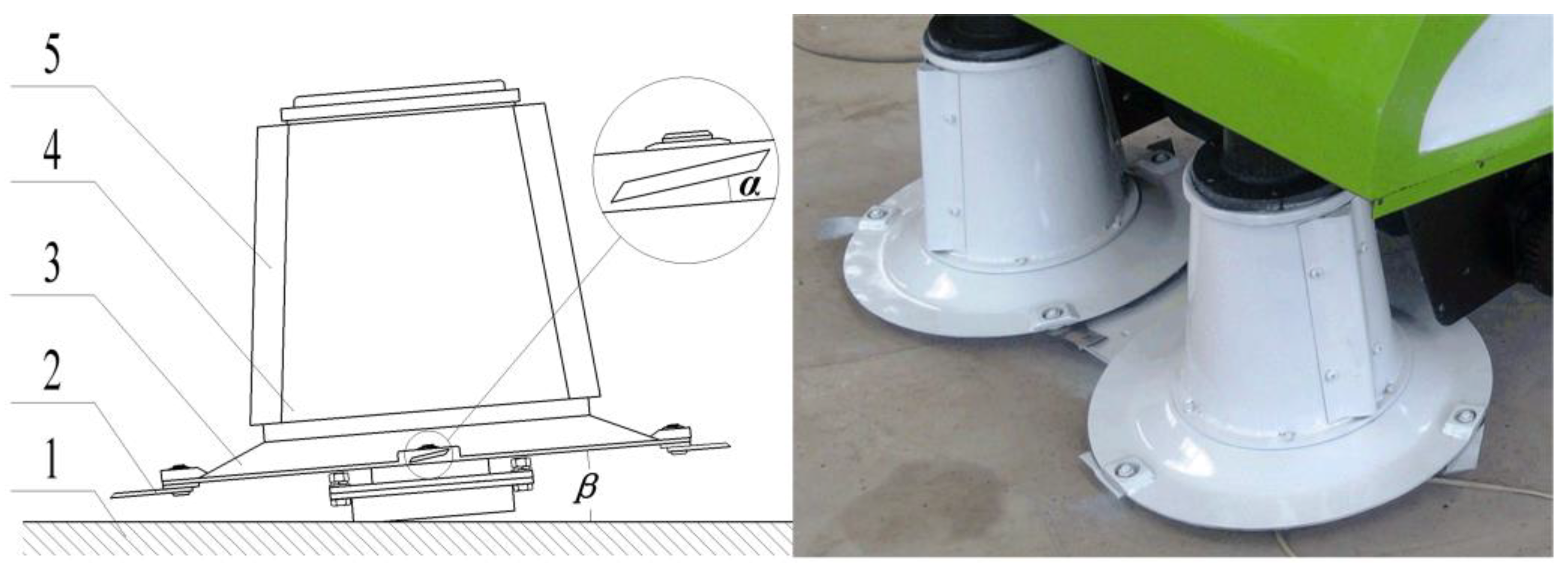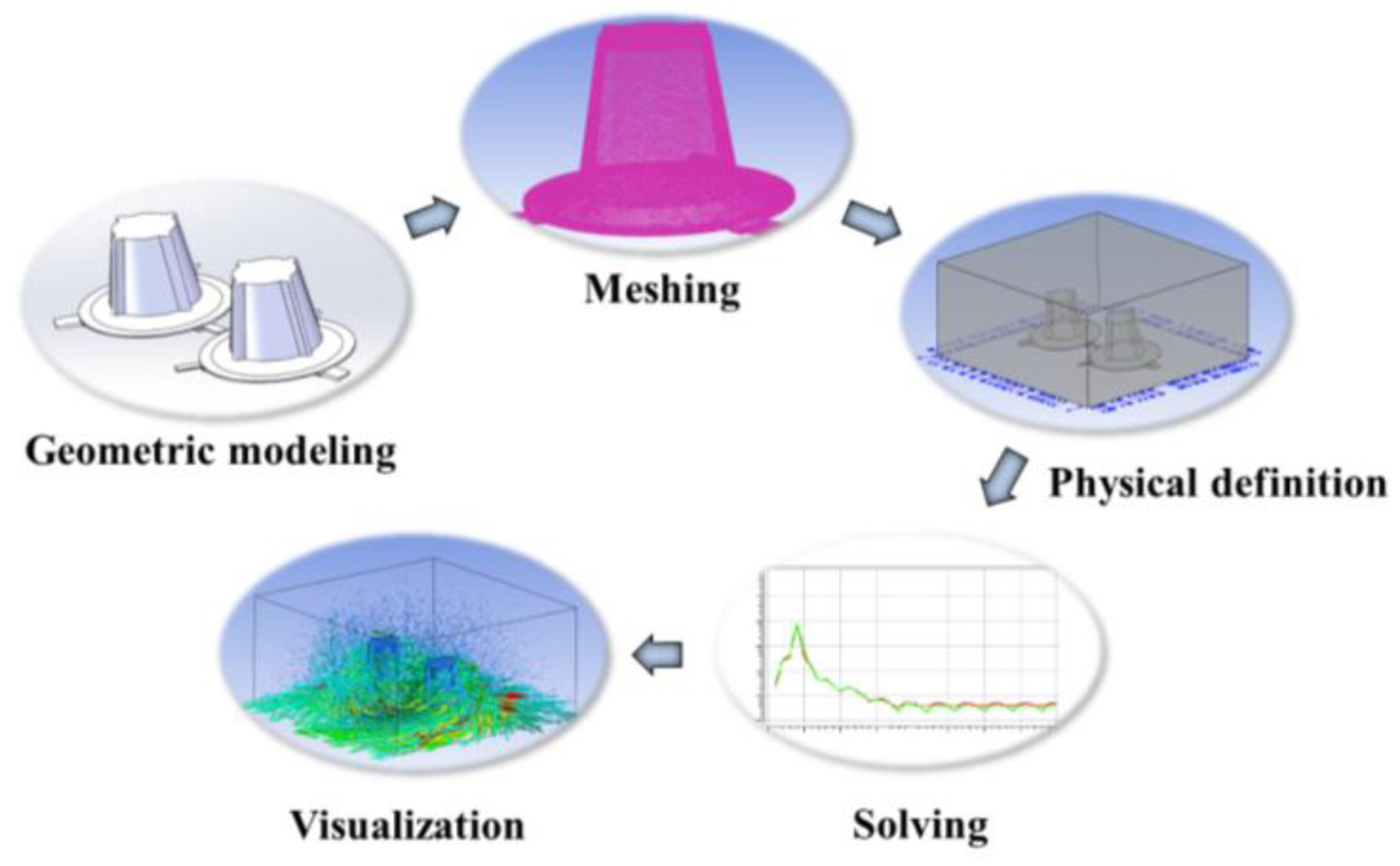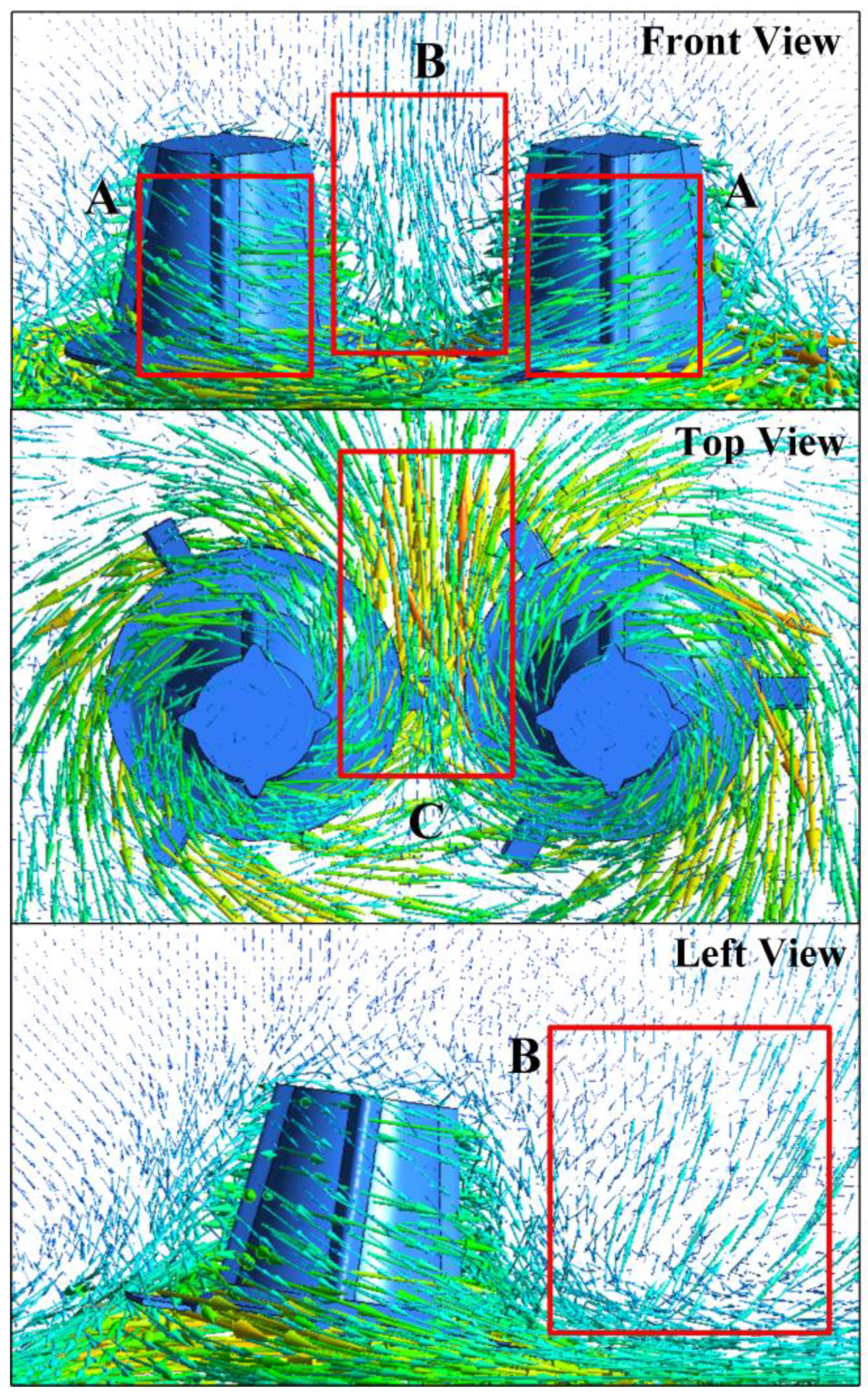Numerical Simulation and Optimization of the Airflow Field of a Forage Drum Mower
Abstract
1. Introduction
2. Cutter Structure and Theory Analysis
2.1. Structure of Double-Drum Cutter
2.2. Theory Analysis of Airflow Field
3. Material and Method
3.1. Numerical Simulation
3.1.1. Simulation Scheme
3.1.2. Simulation Parameters
3.2. Orthogonal Experiments
3.2.1. Experimental Factors and Evaluation Indexes
3.2.2. Measurement Methods of Evaluation Indexes
3.2.3. Methodology of Statistical Analysis
4. Results and Discussion
4.1. Distribution of Airflow Field
4.2. Results of Orthogonal Experiments
4.3. Optimal Parameters and Regression Models
5. Verification Experiments
5.1. Simulation Verify Experiments
5.2. Test Bench Verify Experiments
6. Conclusions
- (1)
- A theoretical analysis of the airflow field around the double-drum cutter was conducted to construct a numerical simulation model of the airflow field of the double-drum cutter for analysis of the distribution of the airflow field and its impact on the process of forage cutting.
- (2)
- A four-factor, three-level orthogonal simulation experiment was performed using a numerical simulation model of the airflow field of the double-drum cutter. Also, the optimal structure and operating parameters of the cutter were determined by using the integrated balance method as follows: a disc speed of 2000 r/min, a blade twist angle of 8°, a disc tilt angle of 4°, and 2 grass guide plates. Under these conditions, the numerical simulation of the airflow field was conducted to find out that the velocity of the lifting airflow was 7.5814 m/s, that of the feeding airflow was 11.4379 m/s and that of the gathering airflow was 4.1857 m/s. All of them are larger in terms of airflow speed, and the airflow field formed is expected to promote the feeding of forage and the reduction of recutting.
- (3)
- The model of airflow field characteristics parameters prediction was constructed, and a test bench was built according to the optimal structure parameters of the cutter. According to the results of verification experiments, the average error of the prediction model was −5.83% for the velocity of the gathering airflow, 2.37% for the lifting airflow, and 4.20% for the feeding airflow, which confirms the validity of the simulation results and the prediction model. The results of the study provide a practical reference for the optimal design of the double-drum cutter.
Author Contributions
Funding
Institutional Review Board Statement
Informed Consent Statement
Data Availability Statement
Conflicts of Interest
References
- Li, B. Agricultural Mechanics, 2nd ed.; China Agriculture Press: Beijing, China, 2018. [Google Scholar]
- Atallah, M.M. Development of a mower for grass harvesting. J. Soil Sci. Agric. Eng. 2014, 5, 203–217. [Google Scholar] [CrossRef]
- Nguyen, T.K.; Minh, C.N.; Ngoc, T.T.; Trung, T.B. Experimental research to determine the optimal working regime of a twin-drum mower for the dragon fruit orchards in Vietnam. In AIP Conference Proceedings; AIP Publishing LLC: College Park, MD, USA, 2021; p. 020037. [Google Scholar] [CrossRef]
- Pruitt, M.E.; Nafziger, B.; Schroeder, J.W. Fixed Rotary Knife. U.S. Patent 13,399,630, 17 February 2012. [Google Scholar]
- Pruitt, M.E.; Nafziger, B.; Schroeder, J.W. Bell Knife for Rotary Mower. U.S. Patent 13,399,603, 23 August 2012. [Google Scholar]
- Pruitt, M.E.; Nafziger, B.; Schroeder, J.W. Fixed Rotary Knife with Multiple Cutting Surfaces. U.S. Patent 8,695,316, 15 April 2014. [Google Scholar]
- Dan, C.; Shao, X.; Liu, T.; Yang, M. Simulation of Minitype Grass Trimmer’s Cutter Deformation. Trans. Chin. Soc. Agric. Mach. 2010, 41, 80–83. [Google Scholar] [CrossRef]
- Kumawat, L.; Raheman, H. Laboratory Investigations on Cutting Torque and Efficiency for Topping of Onion Leaves Using Wire-Type Rotary Unit. J. Biosyst. Eng. 2022, 47, 428–438. [Google Scholar] [CrossRef]
- Hosseini, S.S.; Shamsi, M. Performance optimization of a rotary mower using Taguchi method. Agron. Res. 2012, 10, 49–54. [Google Scholar]
- Ismail, Z.; El-Hadidi, Y.; El-Saadany, M. The utilization of a developed disc mower to remove the vegetative tops of some tuber crops. Misr. J. Ag. Eng 1993, 10, 508–524. [Google Scholar]
- Wu, B.; Wang, D.; Wang, G.; Fu, Z.; Kang, C. Optimization and experiments of cut-condition device working parameter on mower conditioner. Trans. Chin. Soc. Agric. Mach. 2017, 48, 76–83. [Google Scholar] [CrossRef]
- Xie, S.; Zhao, H.; Yang, S.; Xie, Q.; Yang, M. Design, analysis and test of small rotary lawn mower of single-disc type. INMATEH-Agric. Eng. 2020, 62, 89–98. [Google Scholar] [CrossRef]
- Tuck, C.; O’Dogherty, M.; Baker, D.; Gale, G. Field experiments to study the performance of toothed disc mowing mechanisms. J. Agric. Eng. Res. 1991, 50, 93–106. [Google Scholar] [CrossRef]
- Kemper, S.; Lang, T.; Frerichs, L. Analysis of the overlaying cut in rotary mowers. Landtechnik 2012, 67, 346–349. [Google Scholar]
- Wang, D.; Fu, Z.; Wang, G.; Gao, D.; Yuang, H.; Ma, X.; Liang, F.; Sun, J. A Small Self-Propelled Alfalfa Mower Conditioner. China Patent ZL2012102037054, 20 June 2012. [Google Scholar]
- Fu, Z. Study on Cutting System for Two Discs Mower Conditioner. Ph.D. Thesis, China Agricultural University, Beijing, China, 2014. [Google Scholar]
- Wu, B. Optimization and Experimental Study on Mechanical System of Alfalfa Mower Conditioner. Ph.D. Thesis, China Agricultural University, Beijing, China, 2014. [Google Scholar]
- Wu, B.; Wang, D.; Wang, G.; Fu, Z.; Guo, Z. Simulation analysis and experiment of profiling device of small self-propelled mower. Trans. Chin. Soc. Agric. Mach. 2015, 46, 123–129. [Google Scholar] [CrossRef]
- Kim, H.J.; Kim, S.H. A Study on Air Flow Characteristics of Mid mower for Tractor (I). J. Korean Soc. Manuf. Proc. Eng. 2015, 14, 27–35. [Google Scholar] [CrossRef]
- Zhang, L. Study of the Airflow Field and Dynamics of the Blade of a Commercial Ride-On Lawn Mower. Master’s Thesis, Nanjing University of Science and Technology, Nanjing, China, 2009. [Google Scholar]
- Chon, W.; Amano, R.S. Experimental and computational investigation of triple-rotating blades in a mower deck. JSME Int. J. Ser. B-Fluid T. Eng. 2003, 46, 229–243. [Google Scholar] [CrossRef]
- Čedík, J.; Chyba, J.; Pexa, M.; Petrásek, S. Influence of shape of cutting tool on pressure conditions in workspace of mulcher with vertical axis of rotation. Agron. Res. 2017, 15, 1530–1539. [Google Scholar] [CrossRef]
- Giordano, A.J. Pressure mapping under an operating lawn mower deck. J. Acoust. Soc. Am. 1995, 98, 2884. [Google Scholar] [CrossRef]
- Chon, W.; Amano, R.S. Investigation of flow behavior around co-rotating blades in a double spindle lawn mower deck. Int. J. Rotating Mach. 2005, 2005, 763964. [Google Scholar] [CrossRef]
- Čedík, J.; Pexa, M.; Chyba, J.; Vondrášek, Z.; Pražan, R. Influence of blade shape on mulcher blade air resistance. Agron. Res. 2016, 14, 337–344. Available online: http://www.vuzt.cz/svt/vuzt/publ/P2016/018.pdf (accessed on 15 August 2022).
- Yu, Y.; Zhang, L.; Li, J.; Shi, W. The different air movement under the different blade angle in mower. Machinery 2010, 37, 1–2. [Google Scholar]
- Zu, L.; Zhang, L.; Wang, H.K. Optimization design of the lawn mowing vehicle’s blade based on aerodynamics. Adv. Mater. Res. 2011, 199, 173–181. [Google Scholar] [CrossRef]
- Mateski, C.J.; Haney, D.W.; Davey, A.L. Airflow Management. U.S. Patent 8,290,629, 16 October 2012. [Google Scholar]
- Li, W.; Zhou, X. Noise Testing and Analysis of Small Mowers. For. Mach. Woodwork. Equip. 2014, 42, 20–22. [Google Scholar] [CrossRef]
- Davidge, E.D. Study on Airflow and Vibraton in a Cutting/Collection/Discharge Lawn Care System. Ph.D. Thesis, Ryerson University, Toronto, ON, Canada, 2004. [Google Scholar]
- Gokool, T.; Chowdary, B.V. Design and Development of a Low-Noise Lawnmower Blade: Application of CAD, CAE and RP Tools and Techniques. West Indian J. Eng. 2017, 40, 11–16. Available online: https://sta.uwi.edu/eng/wije/vol4001_jul2017/documents/M02_17001_v40n1p11-16_TGokoolJul1707.pdf (accessed on 15 August 2022).
- Mahoney, D.P.; Mahoney, B.D.; Spear, J. Lawn Tractor Noise Reduction: Results of a Noise Dosimetry Study. Prof. Saf. 2017, 62, 52–57. Available online: https://www.jespear.com/documents/Lawn%20Tractor%20Noise%20Reduction%20Article.pdf (accessed on 15 August 2022).
- Jiang, E.; Jiang, Y. Studies on the Characteristics of Airflow Field Surrounding the Stripping Rotor with Triangle Plate Teeth. Trans. Chin. Soc. Agric. Eng. 2000, 16, 59–62. [Google Scholar]
- He, W. Optimization of Experimental Design Methods and Data Analysis; Chemical Industry Press: Beijing, China, 2014. [Google Scholar]








| Level | Factors | |||
|---|---|---|---|---|
| A | B | C | D Number of Guide Plates | |
| Disc Speed | Blade Twist Angle | Disc Tilt Angle | ||
| (r/min) | (Degrees) | (Degrees) | ||
| 1 | 1500 | 0 | 0 | 0 |
| 2 | 1750 | 4 | 4 | 2 |
| 3 | 2000 | 8 | 8 | 4 |
| Indexes | Test NO. | A | B | C | D | vg/(m/s) | vl/(m/s) | vf/(m/s) |
|---|---|---|---|---|---|---|---|---|
| 1 | 1 | 1 | 1 | 1 | 3.024 | 3.915 | 7.3798 | |
| 2 | 1 | 2 | 2 | 2 | 3.051 | 5.3464 | 8.6026 | |
| 3 | 1 | 3 | 3 | 3 | 3.289 | 5.011 | 8.356 | |
| 4 | 2 | 1 | 2 | 3 | 4.2509 | 6.228 | 9.7953 | |
| 5 | 2 | 2 | 3 | 1 | 3.2886 | 5.9595 | 9.0892 | |
| 6 | 2 | 3 | 1 | 2 | 4.2224 | 4.5995 | 9.0434 | |
| 7 | 3 | 1 | 3 | 2 | 3.927 | 6.6839 | 11.332 | |
| 8 | 3 | 2 | 1 | 3 | 4.6207 | 5.2443 | 10.581 | |
| 9 | 3 | 3 | 2 | 1 | 4.0266 | 7.782 | 10.960 | |
| vg | K1 | 3.1213 | 3.7340 | 3.9557 | 3.4464 | |||
| K2 | 3.9206 | 3.6534 | 3.7762 | 3.7335 | ||||
| K3 | 4.1914 | 3.8460 | 3.5015 | 4.0535 | ||||
| R | 1.0701 | 0.1926 | 0.4542 | 0.6071 | ||||
| vl | K1 | 4.7575 | 5.6090 | 4.5863 | 5.8855 | |||
| K2 | 5.5957 | 5.5167 | 6.4521 | 5.5433 | ||||
| K3 | 6.5701 | 5.7975 | 5.8848 | 5.4944 | ||||
| R | 1.8126 | 0.2808 | 1.8659 | 0.3911 | ||||
| vf | K1 | 8.1128 | 9.5026 | 9.0017 | 9.1433 | |||
| K2 | 9.3093 | 9.4245 | 9.7862 | 9.6596 | ||||
| K3 | 10.958 | 9.4534 | 9.5927 | 9.5777 | ||||
| R | 2.8457 | 0.0781 | 0.7846 | 0.5163 |
| Indexes | Source of Variation | Sum of | Degree of | Mean Square | F Values | p Values |
|---|---|---|---|---|---|---|
| Squares | Freedom | |||||
| vg | Disc speed | 1.857 | 2 | 0.928 | 33.096 | 0.0293 * |
| Disc tilt angle | 0.314 | 2 | 0.157 | 5.593 | 0.1517 | |
| Number of guide plates | 0.553 | 2 | 0.276 | 9.862 | 0.0921 | |
| Error | 0.056 | 2 | 0.028 | |||
| Total | 128.97 | 9 | ||||
| vl | Disc speed | 4.937 | 2 | 2.4688 | 40.1813 | 0.0243 * |
| Disc tilt angle | 5.489 | 2 | 2.7448 | 44.6732 | 0.0219 * | |
| Number of guide plates | 0.272 | 2 | 0.1362 | 2.2171 | 0.3108 | |
| Error | 0.122 | 2 | 0.0614 | |||
| Total | 297.217 | 9 | ||||
| vf | Disc speed | 12.249 | 2 | 6.124 | 1309.118 | 0.0008 ** |
| Disc tilt angle | 1.002 | 2 | 0.501 | 107.119 | 0.0092 ** | |
| Number of guide plates | 0.462 | 2 | 0.231 | 49.380 | 0.0198 * | |
| Error | 0.009 | 2 | 0.0047 | |||
| Total | 819.179 | 9 |
| Indexes | Simulated Values | Model Predicted Values | Error (%) |
|---|---|---|---|
| (m/s) | (m/s) | ||
| Gathering airflow velocity vg | 4.1857 | 4.3355 | +3.58 |
| Lifting airflow velocity vl | 7.5814 | 6.6416 | −12.4 |
| Feeding airflow velocity vf | 11.4379 | 10.8584 | −5.07 |
| Indexes | Disc Speed (m/s) | Model Predicted Values (m/s) | Measured Value (m/s) | Error (%) |
|---|---|---|---|---|
| Gathering airflow velocity vg | 1480 | 2.62 | 2.88 | −9.03 |
| 1780 | 3.26 | 3.38 | −3.55 | |
| 1960 | 4.25 | 4.47 | −4.92 | |
| Lifting airflow velocity vl | 1480 | 4.76 | 4.53 | 5.08 |
| 1780 | 5.84 | 5.69 | 2.64 | |
| 1960 | 6.5 | 6.54 | −0.61 | |
| Feeding airflow velocity vf | 1480 | 7.46 | 7.21 | 3.47 |
| 1780 | 9.17 | 8.64 | 6.13 | |
| 1960 | 10.63 | 10.32 | 3.00 |
Disclaimer/Publisher’s Note: The statements, opinions and data contained in all publications are solely those of the individual author(s) and contributor(s) and not of MDPI and/or the editor(s). MDPI and/or the editor(s) disclaim responsibility for any injury to people or property resulting from any ideas, methods, instructions or products referred to in the content. |
© 2023 by the authors. Licensee MDPI, Basel, Switzerland. This article is an open access article distributed under the terms and conditions of the Creative Commons Attribution (CC BY) license (https://creativecommons.org/licenses/by/4.0/).
Share and Cite
Wu, B.; Zuo, T.; Li, Z.; Qian, H.; Huang, T.; Xiang, Y. Numerical Simulation and Optimization of the Airflow Field of a Forage Drum Mower. Appl. Sci. 2023, 13, 5910. https://doi.org/10.3390/app13105910
Wu B, Zuo T, Li Z, Qian H, Huang T, Xiang Y. Numerical Simulation and Optimization of the Airflow Field of a Forage Drum Mower. Applied Sciences. 2023; 13(10):5910. https://doi.org/10.3390/app13105910
Chicago/Turabian StyleWu, Bei, Tianlin Zuo, Zhuo Li, Huaiyuan Qian, Tianci Huang, and Yang Xiang. 2023. "Numerical Simulation and Optimization of the Airflow Field of a Forage Drum Mower" Applied Sciences 13, no. 10: 5910. https://doi.org/10.3390/app13105910
APA StyleWu, B., Zuo, T., Li, Z., Qian, H., Huang, T., & Xiang, Y. (2023). Numerical Simulation and Optimization of the Airflow Field of a Forage Drum Mower. Applied Sciences, 13(10), 5910. https://doi.org/10.3390/app13105910






